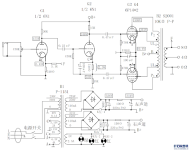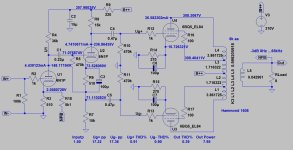Can one of you wonderful people please help a relative newbie with a strange problem.
I have recently built this tube amp from the attached schematic and while it is giving me full range audio it always sounds like listening to well worn records at any volume.
Running on Quad esl 53’s.
My 303 sounds fine so not the speakers.
I have recently built this tube amp from the attached schematic and while it is giving me full range audio it always sounds like listening to well worn records at any volume.
Running on Quad esl 53’s.
My 303 sounds fine so not the speakers.
Attachments
What do you mean by "well worn records"? No bass, no highs?
What kind of output transformer did you use?
What kind of output transformer did you use?
I’m using the That's audio el84 15 watt push pull opt’s
And it is like course in the mid range fuzzy if you like
And it is like course in the mid range fuzzy if you like
Any amp with significant feedback is going to need some tuning to accomodate a different output transformer than the one it was designed for. Do you have an oscilloscope? Have you looked at some square waves? Chances are either the transformer is bandwidth-limited, or it's oscillating at high frequencies.
The circuit diagram doesn't show any grid stoppers. When really absent, adding them could solve the issue.
I have added 1k grind stoppers to the 6p14s
And the same to the input of V1
I am also using separate cathode resistors on V3 and 4
And the same to the input of V1
I am also using separate cathode resistors on V3 and 4
What value cathode resistors and bypass caps?
Do you use the same parts as in the schematic, and were they part of a kit?
Do you use the same parts as in the schematic, and were they part of a kit?
I wouldn't be so sure about that.Running on Quad esl 53’s.
My 303 sounds fine so not the speakers.
Quad 303 has 45W at 8 Ohm output (with low output impedance), 6P14 PP generally produces only 8-10W with even -relatively- large output impedance (without NFB).
If the loudspeaker (I haven't even heard of ESL-53) is static type, the 10W is potentially insufficient (for example ESL 63 nominally 8R impedance even falls down to 3R5).
The schematic shows thew cathode to be 10.6V above ground, so that implies (from I = V/R), 10.6/130 idle current, i.e. 81mA or about 40mA each.So should I link the cathodes and use one 150 ohm resistor?
If you can source matched tubes and are prepared to test them and replace them at intervals, then shared cathode bias is OK. In some cases the amplifier designs use it as a design feature and not just for expediency.
Individual cathode bias is an easy route to not having to worry so much about the matching of the output pairs, and handles the aging of individual tubes. To achieve the same affect R = V/I, 10.6/40, so 265ohms. 270R is a standard value. Power dissipatated is 0.04A * 10.6V = 0.43W, peak would be twice that, so 3W or 5W is probably OK. I think the bypass capacitor is OK, your 220uF or the original 100uF.
- Home
- Amplifiers
- Tubes / Valves
- New build problem


